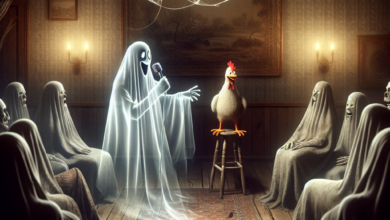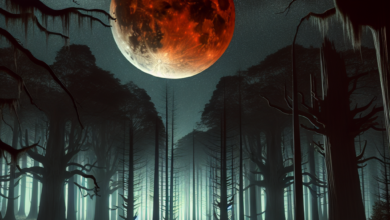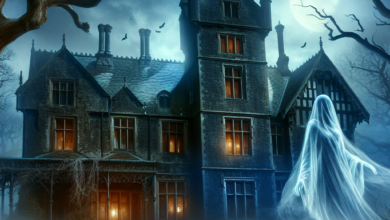The Last Breath: A Farewell from the Grave
As the waning sun dipped below the horizon, casting long shadows over the small town of Eldermore, the air grew thick with an unsettling silence. It was the kind of silence that hinted at secrets long buried, and on that fateful evening, one such secret was about to awaken from its slumber.
At the edge of town, overlooking the rolling hills and dense woods, stood an old, sprawling cemetery. Among the weathered tombstones and ancient oaks lay a grave marked by a cracked marble headstone inscribed with the name Eleanor Gracefield. She had passed nearly a decade earlier, yet her story lingered in hushed whispers among the townsfolk.
Eleanor had been a woman of fervent passions, a local artist whose canvases captured the wild beauty of Eldermore. But her life had been overshadowed by tragedy—a mysterious illness that claimed her life at only thirty-five. To many, her passing was a cruel twist of fate; for others, it was a welcomed closure to a troubled soul.
Lila Carter had known Eleanor in life. As a child, she often watched the artist paint in her garden, mesmerized by the way she transformed simple landscapes into vibrant expressions of emotion. Now, as a young woman, Lila found herself returning to Eldermore after years away, seeking solace from the tumult of city life. The moment she stepped into the quaint town, memories flooded back, old and aching.
Encouraged by nostalgia, Lila visited the cemetery, her heart heavy with the weight of memories. As she stood before Eleanor’s grave, an inexplicable chill coursed through her—an electric pulse that sent shivers down her spine. The sun dipped lower, and a raven perched nearby let out a sharp caw, breaking the silence and startling her.
“What would you say to me now?” Lila whispered to the gravestone, tracing her fingers over the faded letters. Part of her half-expected a response, a glimpse into Eleanor’s troubled soul. “You were taken too soon.” Her voice quivered, and she dropped to her knees, lost in thought.
Unbeknownst to Lila, a shadow occupied the space beside her, its form barely discernible against the backdrop of the dimming light. She sensed it—a presence, something otherworldly. Heart racing, she turned her head, but there was nothing there. Just the rustling leaves and the distant sound of a train whistle echoing through the valley.
When she finally stood to leave, Lila brushed the dirt from her knees and felt a sense of finality wash over her. She turned to take one last look at Eleanor’s grave, but her gaze stopped short—a small, weather-beaten journal rested against the base of the headstone, its edges frayed and the cover a forlorn brown.
“Eleanor?” she breathed, a thrill of curiosity igniting within her. She picked up the journal, feeling the weight of it in her hands—the stories within calling out to her like a voice from the past. The lock was broken, and she flipped it open to the first page, her heart racing with every word written in Eleanor’s distinctive script.
Dear Reader,
If you have found this journal, it means I have moved on beyond this world. My heart is heavy with secrets too long buried; I hope that in sharing them, I can find some measure of peace in the afterlife. If you are reading this, I implore you to understand: my last breath will be my farewell from the grave.
Lila’s breath caught in her throat, and she quickly glanced around as if someone might witness this intimate moment. The words pulled her in, and she couldn’t resist continuing.
I, Eleanor Gracefield, have spent my days painting the beauty of life while concealing the darkness that lurked within. My art was my sanctuary, but it was also a canvas for my fears. There are things that haunt me still, and I hope to lay them to rest in these pages.
With shaking hands, Lila turned to the next pages, eager to uncover Eleanor’s hidden truths. As she read, the sun yielded to the twilight, and the cemetery transformed under the soft glow of the moonlight.
It began with the whispers, the journal recounted. The townsfolk always found solace in my art, often commenting on how my landscapes seemed to capture the very essence of the spirit of Eldermore. They were unaware that the true muse behind my creations, the inspiration for the vibrant colors and swirling strokes, often came from the shadows of my existence. I painted to escape, to breathe life into specters that haunted me.
Lila was transfixed, her own shadows now merging with Eleanor’s. She turned page after page, each one peeling back layers of Eleanor’s life—her deepest fears, her relationships, and the tumultuous love that had once set her heart ablaze.
I fell in love with James, Eleanor had written, her words curling with passion and longing. He was a kindred spirit, an artist as well. Our souls danced together in colors and shades, but as with all things of beauty, it was ephemeral. A darkness loomed over our love—a secret that gnawed at the edges of our happiness.
Lila felt a pang of empathy as she could almost hear Eleanor’s voice, bittersweet and troubled. She continued to read about the struggles they faced; how James was haunted by his past—how the town’s narrow-mindedness and whispers of scandal consumed their relationship. As Lila read, she realized just how closely Eleanor’s narrative echoed her own feelings of isolation and lost love.
Eleanor wrote of the turning point, the moment when fear eclipsed love. A confrontation, she described. When I learned of his indiscretions with another, I spiraled into despair. In my rage, I delivered a cruel ultimatum, unaware that my words would drive him away forever. My passion turned to poison, and I was left with a gaping wound that would never heal.
With tears streaming down her face, Lila recognized the weight of Eleanor’s pain and regret. She closed the journal for a brief moment to compose herself, yet her heart raced to uncover the rest.
The day I fell ill was the day I understood the full consequences of my actions. The later entries grew darker, often filled with the artist’s distressing dreams and visions. I see shadows where there should be light. The weight of my regrets suffocates me, and every stroke of my brush feels like a cry for forgiveness. Yet, I remain voiceless in a landscape teeming with life.
As Lila continued to read, she felt as though she was walking alongside Eleanor during her last moments—through bouts of fevered delirium and clarity. She savored the vibrant prose Eleanor used to describe her last paintings—breathtaking interpretations of sorrow that spoke to the depths of loneliness.
I would give anything to paint one last picture—a summation of my existence, an offering to the universe, an apology to those I’ve wronged. The last entry was nearly illegible, as if written in a fit of desperation: If you find this journal, understand that I am bound to this place by what I couldn’t say. There is a secret buried here, and perhaps it is my only hope for redemption. I died with a whisper on my lips, a truth unspoken. Can you uncover it?
Breathless, Lila could feel every pulse of emotion that Eleanor had infused into those words. A mystery had woven itself into her return to Eldermore, and Lila’s heart began to race with the thrill of discovery. She clasped the journal tightly and stood to leave, her footsteps echoing as she made her way out of the cemetery, the air electric with possibility.
That night, Lila sat in her small, nostalgic bedroom, the moonlight spilling through the window as it cast its silvery glow across the floorboards. She poured over the pages of Eleanor’s journal, drawn to the urgency within. Each word was a thread woven into a rich tapestry of regret and longing.
Hours slipped by like minutes, but Lila found herself haunted by the lingering question: What was the truth Eleanor had left unspoken?
Determined to unearth the secret, Lila began her quest by speaking to the elders of Eldermore, hoping to find someone who might shed light on Eleanor’s life. She sought out Mary Thompson, a lovely woman in her eighties who had often sat at Eleanor’s feet during art exhibitions, mesmerized by her talents.
At the rustic café on the corner of Maple and Pine, Lila found Mary seated at a weathered table, a cup of chamomile tea cradled in her gnarled hands. With a gentle smile, Lila approached, her heart stirring with anticipation.
“Mary, do you remember Eleanor Gracefield?” Lila started, eager and hopeful.
“Ah, Eleanor,” Mary reminisced, her eyes twinkling with distant memories. “She brought so much beauty to this town. But,”—her expression sobered—“there were whispers of a heavier heart beneath her radiant paintings. Some say her talent came at a price, that she harbored secrets we could only imagine.”
“Secrets?” Lila probed gently, and Mary leaned closer, lowering her voice.
“There were rumors of a love gone wrong—a man named James. They were quite the pair until tragedy struck. I believe Eleanor never truly recovered. It was said that their romance ended in an argument that would change everything. Some claimed she even painted a final piece before she left us—an apology, perhaps.”
Lila’s heart raced. The last painting—was it still in Eldermore? “Do you know where it is?”
Mary shook her head slowly. “No, dear. But it’s said to lie hidden in the old barn on the outskirts of town, where they used to meet. I wouldn’t step there now; too many shadows from the past linger about, and I fear what they might bring.”
With a surge of fervor, Lila thanked Mary and rushed out of the café, the air around her charged with purpose. She could feel Eleanor’s presence guiding her, propelling her toward the old barn on the edge of town.
Underneath the glimmer of constellations, Lila arrived at the dilapidated structure. Wooden beams buckled with age, ivy climbing its weathered walls, creating an atmosphere both haunting and beautiful. The door creaked open under her touch, revealing a cavern of memories and dust.
In dim light, she scanned the interior; it was as if time had paused within. She could see remnants of long-forgotten moments: an old easel, jars of dried paintbrushes, and scattered canvases piled against the walls. Her heart raced at the thought of finding Eleanor’s final masterpiece.
As she sifted through the memories, Lila stumbled upon a canvas tucked into the shadows. Breathless, she grabbed it, pulling it free and holding it up to the light. The painting was extraordinary—wild swirls of color intertwining with chaotic lines and shadows that spoke of anguish and beauty. Lila’s heart thudded; she could see her own sorrow reflected within it.
And there, at the corner of the canvas, was a message. A small inscription read, “Forgive me.” Eleanor had poured her soul into this final piece, a testament not just to love lost but to the journey of finding solace within oneself.
As tears welled in her eyes, Lila understood—the secret wasn’t merely about Eleanor’s regrets, but about healing and the power of forgiveness. She took a moment to stand in silence, enveloped by the memories of Eleanor, and with every beat of her heart, she vowed to ensure that the artist’s spirit lived on, unburdened.
With the dawn creeping into the sky, Lila returned home, her heart lightened by the weight lifted from Eleanor’s soul. She would curate an exhibition to share Eleanor’s journey with the townsfolk, to shine light on the shadows of their lives, and to remind them that love—however lost—could always be redeemed.
On the opening night of the exhibition, the townsfolk gathered within the walls of the old community center. Lila stood at the entrance, and her heart surged with anticipation as she welcomed each guest, their whispers of intrigue reverberating against the canvas-covered walls.
The apex came when she unveiled Eleanor’s final painting. Gasps filled the room as they beheld the raw emotion flooded within the colors. For Lila, it was like standing with Eleanor again, feeling the artist’s spirit flowing through her.
At the center of the exhibit, beneath a spotlight, Lila shared Eleanor’s story—her passions, her heartbreak, and the haunting beauty of her creation. As Lila spoke, she felt herself becoming part of something larger, knit together by the collective heartbeat of the audience.
At that moment, Lila realized Eleanor’s truth was a living legacy, inviting others to reflect on their own shadows and to embrace the possibility of forgiveness and healing. The emotional weight surrounding Eleanor’s last breath was finally understood—it was not merely a farewell from the grave but a call to live fully, to love deeply, and to forgive unconditionally.
As the night wore on and the space filled with laughter and connection, the flickering lights cast a warm glow on Eleanor’s painting, now a beacon of hope. And within that hallowed room, Lila felt the echoes of Eleanor’s spirit whispering a soft, final farewell.
In the stillness that followed, Lila closed her eyes, allowing herself to be enveloped by gratitude. Eleanor Gracefield had offered a farewell not just from the grave, but also a lesson in life, an enduring bond forged in the depths of tragedy and transformed into a radiant testament of love.
As the last breath of the past intertwined with the promise of the present, Lila stood resolute, one with the whispers of the night, finally unearthing the truths that had long remained silent beneath the layers of time.





